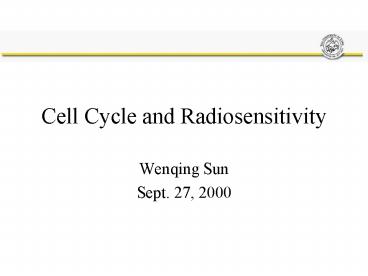Cell Cycle and Radiosensitivity PowerPoint PPT Presentation
1 / 32
Title: Cell Cycle and Radiosensitivity
1
Cell Cycle and Radiosensitivity
- Wenqing Sun
- Sept. 27, 2000
2
Agenda
- Definition of cell cycle
- Radiosensitivity at different cell phase
- Cell cycle checkpoint
- Other aspects of radiation biology and cell cycle
3
Definition of Cell Cycle
- Cell Cycle is ordered process by which one cell
grows and divides into two daughter cells.
4
Phases of Cell Cycle
- Mitosis - M phase
- One cell divides into two identical cells.
- Typically lasts for 30 minutes.
5
Phases of Cell Cycle - continued
- Interphase
- S phase
- Lasts 6 hours.
- DNA synthesis is restricted to this phase.
- G1 phase
- Duration varies dramatically for different cell
lines. - G2 phase
- Lasts 3 hours.
6
Cell populations and cell cycle phases
7
Cell growth and DNA content during the cell cycle
8
Comparison of Cell Cycle - Hamster and Hela
9
Radiosensitivity at different cell phase
10
Time-survival fraction for Hamster cell
11
Time-survival fraction for HeLa cell
12
Correlation between variation of radiosensitivity
and age
- Cell are most sensitive at or close to mitosis
- Resistance is usually greatest in the latter part
of S phase - If G1 has an appreciable length, a resistant
period is evident early in G1 phase, followed by
a sensitive period toward the end of G1 phase - G2 phase is usually sensitive, perhaps as
sensitive as M phase
13
Cell Cycle Checkpoint
- Definition of cell cycle checkpoint
- Events that can initiate the arrest of cell cycle
at checkpoints - Arrests of each phase
14
Definition of Checkpoint
- Cell cycle is a highly ordered processthe
initiation of later event depends on the
completion of earlier events. - The control mechanisms that enforce this ordered
dependency are called cell cycle checkpoint.
15
Events can initiate arrest
- Nutrient deprivation
- Temperature changes
- Nucleotide depletion
- Damage to the DNA
16
DNA-damage-responded checkpoint
17
Some conception
- Oncogenes
- Tumor suppressor genes
- Cyclin is a family of proteins required for the
activity of some kind of kinases. - Cyclin-dependent kinases a group of kinases that
can regulate cell cycle progress
18
G1 phase arrest
- Avoid DNA replication
- Dependent on the function status of p53
19
G1 arrest and p53 pathway
- Irradiation---gtDNA damage---gt increasing level of
p53 protein---gt activation of p21WAF1/CIP1
gene---gt inhibition the activity of
cyclin/CDK---gt G1 arrest
20
S phase arrest
- After relatively high dose irradiation
- Prevent DNA replication errors
- Inhibiting the initiation of replicon or
inhibiting the elongation of replicon - The mechanism is not clear
21
G2 phase arrest
- Very important checkpoint
- Prevent the cells with damaged DNA to progress
into mitosis
22
Mechanism of G2 arrest
- The control gene in yeast
- cyclin B1 and p34cdc2
- ras oncogene
23
Methods to control checkpoint
- Gene therapy success and difficulty
- drugs
24
Other aspects of cell cycle
- LET
- Hyperthermia
- Cell cycle redistribution
25
LET and cell cycle
26
LET-Respond Cell Cycle Sensitivity
27
Hyperthermia and cell cycle
28
Cell Age-respond Sensitivity to Hyperthermia
29
Mechanism of hyperthermia
- Thermersensitivity and cell cycle
- Biological effect of hyperthermia
- hyperthermia and oxygen
- Block the repair of DNA damage
30
Cell Cycle Redistribution
31
The overall effect of a dose of radiation
- kill cells in a sensitive phase of the cell
cycle - Sensitize a cycling population to a later dose of
radiation. - Leave majority of cells in a resistant cell cycle
phase. - All of the above
32
- Artificial synchronization
- Redistribution(re-assortment)

